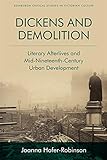Dickens and Demolition : Literary Afterlives and Mid-Nineteenth Century Urban Development / Joanna Hofer-Robinson.
Material type: TextSeries: Edinburgh Critical Studies in Victorian Culture : ECSVCPublisher: Edinburgh : Edinburgh University Press, [2022]Copyright date: ©2018Description: 1 online resource (264 p.) : 19 illustrationsContent type:
TextSeries: Edinburgh Critical Studies in Victorian Culture : ECSVCPublisher: Edinburgh : Edinburgh University Press, [2022]Copyright date: ©2018Description: 1 online resource (264 p.) : 19 illustrationsContent type: - 9781474420983
- 9781474420990
- 823/.8
- PR4592.L58 H64 2018
- online - DeGruyter
| Item type | Current library | Call number | URL | Status | Notes | Barcode | |
|---|---|---|---|---|---|---|---|
 eBook
eBook
|
Biblioteca "Angelicum" Pont. Univ. S.Tommaso d'Aquino Nuvola online | online - DeGruyter (Browse shelf(Opens below)) | Online access | Not for loan (Accesso limitato) | Accesso per gli utenti autorizzati / Access for authorized users | (dgr)9781474420990 |
Frontmatter -- Contents -- List of Illustrations -- Acknowledgements -- Series Editor’s Preface -- Abbreviations and a Note on Editions -- Introduction -- Chapter 1 Charles Dickens and Metropolitan Improvements -- Chapter 2 Sets and the City: Staging London and Oliver Twist -- Chapter 3 Dickensian Afterlives and the Demolition of Field Lane -- Chapter 4 Paperwork and Philanthropy: Dickens’s Involvement in Metropolitan Improvement -- Chapter 5 From Sanitary Reform to Cultural Memory: The Case of Jacob’s Island -- Coda -- Archival Sources and a Note on Method -- Select Bibliography -- Index
restricted access online access with authorization star
http://purl.org/coar/access_right/c_16ec
Traces and measures the material impact of Dickens’ fiction in London’s built environmentDickens and Demolition examines how tropes, characters, or extracts from Dickens’ fiction were repurposed as a portable terminology in arguments for large-scale demolition and redevelopment projects in London during his lifetime. Commentators with public voices repeatedly mobilised a Dickensian vocabulary to communicate their opinions about how and where London’s built environment should be improved in the mid-nineteenth century, or to justify proposed alterations. In analysing allusions to Dickens in a variety of archival sources, including dramatizations, press reports, political debates, and the visual arts, this book asks what cultural work is performed by literary afterlives, and whether we can trace their material effects in the spaces we inhabit.Key FeaturesIntersects with cross-disciplinary scholarly interests in studies of Dickens, histories of London, literary afterlives and urban studiesThe first study of how Dickens’s works were appropriated and mobilised by other people within his lifetimeOffers close analyses of literary and non-literary textsEngages with critical discourse around of literary afterlives
Mode of access: Internet via World Wide Web.
In English.
Description based on online resource; title from PDF title page (publisher's Web site, viewed 29. Jun 2022)


